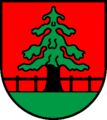Tree (heraldry)

The tree is a common figure in heraldry , reduced to a stylized representation.
Basically, a distinction is made between grown and uprooted (uprooted) trees . The latter is with roots represented, often colored differently ( tinged may be). Torn up is explicitly emblazoned , the tree has grown up without any information.
Often trees are shown growing on a mountain, often the Dreiberg , otherwise a shield base (in green, black or natural colors ) also serves as a base. Grown and uprooted forms occur here.
One speaks of up to about 4, 5 trees by tree (if the number is specified, there are also more trees specified), otherwise by forest .
All kinds of trees are represented in coats of arms .
Tree in general is always a - unspecific - deciduous tree , otherwise it can also be given without leaves for a trunk with branches. Popular representations of deciduous trees are, for example, linden and oak as solitaires and birch as characteristic landscape elements; Fruit trees such as pears, apples and cherries are popular because of their clearly representable blossoms or fruits.
Among the conifers in Central Europe, the fir ( abies , silver fir) or the spruce ( picea , red fir) appear in the coat of arms , often in pairs or in groups next to each other. If the blazon is not fixed, one also speaks unspecifically of forest trees and generally means 'conifer'. Forest / conifer, fir and spruce are represented largely the same, the latter two possibly differ in the fruit (standing or hanging cones).
Of the more exotic tree species, the cedar is known in the coat of arms ( Lebanon’s coat of arms ); outside of Europe , trees such as the palm are also popular.
Trees can explicitly flowering or fruiting be represented, fruit trees, as well as about bezapfte conifers. Depending on the type of tree, the leaves, fruits and flowers are displayed disproportionately large and limited to a smaller number. This number is important in many coats of arms and must then be noted ( emblazoned ) in the description .
Also represented as a common figure in coats of arms are parts of the tree (such as stumps / stick / trunk ), thick branches in a simplified form or twigs, leaves and fruits (for example acorns ) with a corresponding blazon. Branches are also shown crosswise, preferably diagonally , and treated in this form as a cross .
- Forms of representation
Tree stump in mixed up colors ( Dönitz DE)
Trunk with stumps ( Oberstammheim CH) (speaking)
- Tree species
Apple tree
( Baumgarten AT, speaking )Birch
( Birkenwerder DE, speaking)Copper beech
( Buch am Irchel CH, speaking)Double oak
( Looft NL)Oak tree , fruiting
( Offenbach a. M. DE)Two alders , flowering or fruiting
( Leppävirta FI)Ash
( Eschenbach , speaking)Chestnut , fruiting
( Castasegna IT, speaking)Bay tree
( Llorenç del Penedès ES)Willow (as pollarded willow )
( Widen CH, speaking)

















